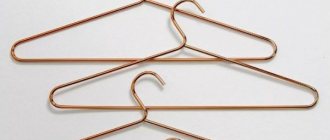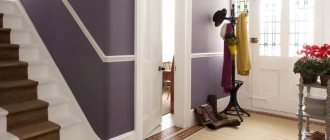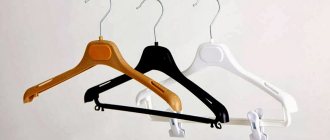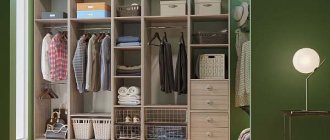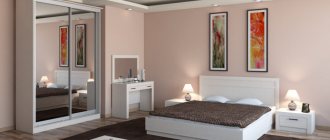It is difficult to imagine a wardrobe without a clothes hanger. It is also called hangers and trempel. There are many different options that differ in their design, material, size and other parameters.
Types of floor hangers and their location
Floor hangers can be divided into several categories according to their design characteristics:
- for outerwear;
These standing hangers are most often seen near doors. - racks for hanging hangers;
- suit, for shirts, trousers;
- hanging chairs.
Some types of floor hangers are placed in certain rooms. For example, hangers for outerwear are placed in the hallway near the door. This is convenient: you can immediately get rid of clothes. A floor hanger with hangers is more versatile. Such products can be placed in the hallway, in the dressing room, even in the nursery or bedroom. They accommodate a large amount of clothing and can replace a wardrobe.
Hanging racks are good in bedrooms and dressing rooms or in those rooms that replace them
Standing hangers for suits, shirts and trousers are most often “registered” in bedrooms or children’s rooms (if the child is a schoolchild). This is where we usually dress before leaving the house. Hanging chairs are also placed there. This is, in fact, one of the options for costume hangers. The legs and supports simply took the shape of the seat.
Standard sizes
An extremely important parameter when choosing clothes hangers is their size. The level of comfort of the owner and the quality of placement of the wardrobe item largely depend on their correct selection. For example, a large shirt or jacket will wrinkle on hangers that are too small.
The standard width of wooden hangers is 45 cm, and metal hangers are 42 cm. Therefore, it is convenient to place clothes from sizes 46 to 50 on them. Plastic models of hangers have a wider range of sizes: from the most compact adult options with a width of 40 cm, to large models that are suitable for clothes of size 56 or more.
A children's hanger has a width from 25 to 38 cm. Similar parameters are characteristic of the most commonly found hangers, although if desired, you can also find models of other scales.
What materials are they made from?
A floor hanger is most often made of metal or wood. Both of these materials are strong, ductile, durable and relatively inexpensive. Some parts - plugs, parts of hooks - can be made of plastic.
Most often you can see floor hangers made of metal and wood
Plastic inserts are more often found on lower cost metal hangers. If the elements of the supporting structure are not made of plastic, this is not bad and you can buy such floor hangers without hesitation. If the elements of the supporting structure are made of plastic, it is better to look for another model.
Metal hangers
The largest selection of metal floor hangers. They are usually made from thin-walled round or square pipes. The metal used most often is black, coated with a protective coating. This can be paint (most often powder coating), nickel plating, chrome plating. In recent years, a new protective coating has appeared - plastic film (PVA). This is also a good option, since the film is impermeable to moisture and air. Such products are easy to care for, since the surface is smooth and without pores.
Several models of metal floor hangers
If the floor hanger will be used to place heavy winter clothes, when choosing, pay attention to the thickness of the metal. The minimum in this case is 1 mm. If the thickness of the pipe wall is not indicated in the product description, most likely the wall is very thin and suitable for light clothing. Indirect signs that will confirm your guesses are the weight of the product and the price.
Wooden
Wooden hangers can be carved from solid wood, or they can be prefabricated. The first option is much more expensive. Prefabricated ones are 2-3 times cheaper, but do not differ too much in appearance. The presence of joints in products of normal quality is hardly noticeable, so if you have a limited budget, it is quite possible to purchase economy class products.
There are different types of wooden floor hangers
Wooden floor hangers are well sanded and covered with a protective coating. Usually varnish or oil is used. The varnish creates a protective film on the surface, making it easy to care for such products. Wood oils do not create a protective film, but they protect no worse. When treated with oil, the structure of the wood is clearly visible - all the fibers, the pattern.
Wall mounted
Simple panel hangers do not require any special disassembly. How to make a wooden wall hanger, see e.g. video.
Video: DIY wall hanger made of wood
https://youtube.com/watch?v=JrF97Cqh7Xg
Here we remember, firstly, about the sconce hanger. Folding, it can be very useful if a large company has gathered or the kids have returned from the yard.
An example of this kind of design is shown on the right in Fig. However, its creators were clearly guided by the principle: “Consumption is the basis of cash circulation.” The outer (folded) side of the flap is inactive and requires a locking mechanism. And a separate hanger for every day.
Compact folding wall hanger
Meanwhile, folding wall hangers have been known since Ancient Egypt. In the climate there, outerwear was worn occasionally, in bad weather, but after wearing it it was necessary to dry it. There was no point in keeping a separate hanger for this in areas where it rains and is cold not once a year, so they came up with one like the one on the right in Fig.
When folded, the compact Egyptian wall hanger was secured with a cypress stick. Now, of course, you can install a ball retainer or just a hook. The main thing is that the hook hooks should be 3/4 of a circle, then nothing will fall off them even with the bar folded back. And without need, the whole hanger looks like just a stick on the wall; You can hang bags, umbrellas, and keys on the hooks.
More about hooks
An original wooden hanger can be made without any metal at all, not counting the fasteners. Do not rush to throw away the New Year's pine or Christmas tree (only the blanks will need to be turned upside down):
Video: original DIY wooden hanger
Such a hanger will look best in a country house, in a timber or frame house. Depending on the interior design – even in a city apartment. It will go well in the bathhouse: touching steamed skin to metal is both unpleasant and, to some extent, even dangerous.
Standing clothes hangers in the hallway
Floor hangers for outerwear in the hallway most often consist of a rod on which hooks for clothes of different lengths and shapes are mounted in a circular pattern at different heights. For stability, the structure is equipped with a round (rarely square) weighted base. They can be made of wood or metal.
The height of the floor stand is 150 cm and above, and the base is a circle with a diameter of 35-45 cm. In order for the hanger to be stable, you need to pay attention to the fact that the lower part is weighted. And all the same, such designs require careful attention: clothes must be hung evenly. Otherwise the hanger may fall.
Floor-standing clothes hanger in the hallway: the most popular models
There are floor hangers for outerwear of this type, but made differently. Several pipes or metal strips are bent with a certain radius. In this case, the upper part is smaller than the lower part. This design is more stable, but requires more space, which is not always possible in a small hallway.
Tips for using the cabinet in different rooms:
1. For the hallway you should choose the simplest possible model, designed for two spacious
2. In the living room, a closet with open side sections on which books, decorative items, small appliances, photographs and indoor flowers are installed looks great.
3. A full-fledged wardrobe with full-length mirrored doors is suitable for the bedroom.
4. In a children's room, you should use a model with rounded corners without mirrors. Such furniture will be safe for the child. Additionally, you can install open side sections and shelving.
5. For an office, you can use a narrow closet without mirrored doors and a compartment for hangers
There are only two types of design: built-in and cabinet-mounted. In the first case, we are talking about a storage system that is placed in niches or corners of the room.
The advantage of a built-in wardrobe is considered to be maximum space saving and reduction in the amount of materials for production.
A free-standing cabinet type of furniture is placed near the wall. This full-fledged cabinet is often complemented by open shelves and mezzanines.
Although its production requires more resources, the undoubted advantage of cabinet furniture is the ability to move during disassembly and subsequent assembly. In the future, such a cabinet can be moved to another room or even sold, while the built-in structure will become an integral part of the room.
Advantages and disadvantages of a wardrobe
A high-quality wardrobe is valued for its functionality, but this does not mean that such furniture does not have flaws. Many potential buyers are put off by the high cost of the cabinet. Although the sliding door mechanism is considered extremely compact, to install it you will have to allocate about 10 cm of the internal space of the cabinet. Additionally, it is recommended to clean the bottom guides on a regular basis to reduce the risk of deformation of the profiles.
Advantages of a sliding wardrobe:
1. Ergonomics, allowing you to rationally organize space in any room.
2. Functionality thanks to thoughtful content.
3. Simplicity and increased convenience at the operating stage.
4. Safety of the door structure. The cabinet can be used by small children.
5. Increased reliability and durability.
6. Attractive, flexible and thoughtful design with extensive decoration options.
A wardrobe with sliding doors can be installed in the bedroom, living room, hallway and children's room. This is extremely ergonomic and compact furniture, which will greatly increase the functionality and comfort of the room. The ability to adjust the configuration of the storage system will allow the customer to independently choose the features of the internal distribution of space.
Dimensions of wardrobes
Cabinet dimensions usually depend on the specific needs of the customer.
The design features of the furniture should also be taken into account. The basic design traditionally consists of three walls (two sides and one back), a lid and a bottom. Shelves and partitions are also installed inside. Built-in types of cabinets are made without walls. The filling components here are attached directly to the ceiling, floor and walls of the room. The assembly of the wardrobe must be carried out according to the instructions from the manufacturer by qualified furniture assemblers. Typical dimensions of sliding wardrobes: 1. Total height from 240 cm, between shelves from 50 cm and for fastening the crossbar about 160 cm. 2. Total width from 120 cm, shelves and drawers from 60 cm. 3. Depth from 50 cm.
There is no universal standard for the manufacture of wardrobes with sliding doors. For example, the depth of the radius corner version of furniture exceeds 80 cm, and part of the structure may be convex. The height depends on the architectural features of the room. This indicator for a built-in structure is usually equal to the distance from floor to ceiling.
Racks for clothes hangers
A hanger rack for clothes on hangers is a convenient thing if there is not enough space in the closets. They consist of a rectangular base, one or two cross-bar pipes, on which hangers with clothes are hung.
A floor hanger for clothes on hangers is also called a stand-up hanger
Rack hangers are made of metal and wood. There are metal ones made from pipes, and there are forged ones. Some models of metal clothing racks have adjustable heights. For long clothes, their stand can be raised higher. The maximum height is 150 cm. For short clothes, you can place it at a height of 80-90 cm. This is the minimum height, and there are also intermediate positions.
Several types of clothing racks on trempels
In some cases, a floor hanger on wheels is useful. It is easy to move from place to place without removing the hanging clothes. There are children's models of floor hangers of this type. They differ only in height and more “cheerful” colors. Children's floor hangers can also be made of plastic. Children's clothing does not weigh that much, so the strength of plastic is more than enough. And in terms of price, plastic floor hangers are the most inexpensive.
Folding models - a solution for entertaining guests
For those who receive large numbers of guests, it can be problematic to place their outerwear. For such cases, there is a folding rack for hangers for outerwear. When folded, it takes up very little space and can be stored in the pantry.
Floor hanger for suit
The problem of storing a business suit is easily solved by purchasing a special floor hanger. It is somewhat similar to racks, only with special hangers for a jacket and a crossbar for trousers.
Floor hanger for suit storage
There are suit stands made of wood, metal and plastic. Plastic in this case is not bad: a large load is not expected, so the strength of modern plastics is more than enough.
If we talk about useful options, this is a shelf or a box. It is convenient to store business small items in it: glasses, cufflinks, wallet, car keys, etc.
Different models of standing suit hangers
Floor hangers for suits are usually placed in the bedroom, in the dressing room. It may be convenient to have such a device in your office. There are different models, you can choose them to suit any interior style. And some options look like designer jewelry themselves.
Hanger-chair and hanger-bedside table
There are quite unusual models of hangers. They are combined with pieces of furniture. For example, there is a hanger-chair. The models are different: with a hanger for a suit, just a hanger bar or with a rack for outerwear. For small apartments this is a very good option. It takes up the same amount of space as a regular chair or banquette, and also serves to store clothes.
Floor hanger with chair and bedside table - for full use of the hallway space
Another option: a bedside table with a hanger. The bottom half of this floor rack is much heavier than the top half, so it won't tip over if you hang a couple of coats. The second advantage of such furniture is the optimal use of space. The problem with all floor hangers is that the bottom 50-60 cm remain unused. This is not the case with the bedside table hanger. This is another good way to rationally use space for small hallways.
About cutting plywood
In any case, parents are faced with problems that little ones don’t care about yet: material consumption and labor intensity. Drawing a complex contour along a grid on a single sheet of plywood is no longer easy; then you need to cut it out precisely, which is even more difficult. And in the end it turns out that 60% or 80% of the material went to waste, no longer suitable for anything. On the contrary, you need to make a children's tree hanger from waste. Or cut a whole sheet more tightly.
Assembling parts of a wooden hanger from plywood
The method for this has long been known: element-by-element cutting and assembly. If the tree is plywood, for complete strength of the finished product, each part is assembled from 2 layers, leaving the corresponding folds and grooves, see fig. Fragments of blanks are assembled using PVA glue, wood glue or “Express” (liquid nails). If the assembly is made of PVA, the fragments must be additionally fastened with small snake nails in increments of 100-150 mm with a distance of 30-40 mm from the edges.
The wooden hanger is assembled using the same adhesives, but now each connection must be secured with wood screws and an envelope. Then the gaps and fastener heads (they need to be recessed during assembly) are rubbed with putty made from sawdust of the same plywood on PVA. Such wood will look solid even without painting, only under varnish.
Note: just in case, let us remind you that before assembly, all wooden parts of any wooden hanger must be sanded with fine sandpaper and treated with a water-polymer emulsion or PVA diluted three to five times with water. After impregnation, before further work, a technological break is taken until the part is completely dry (1-3 days, depending on its size).
